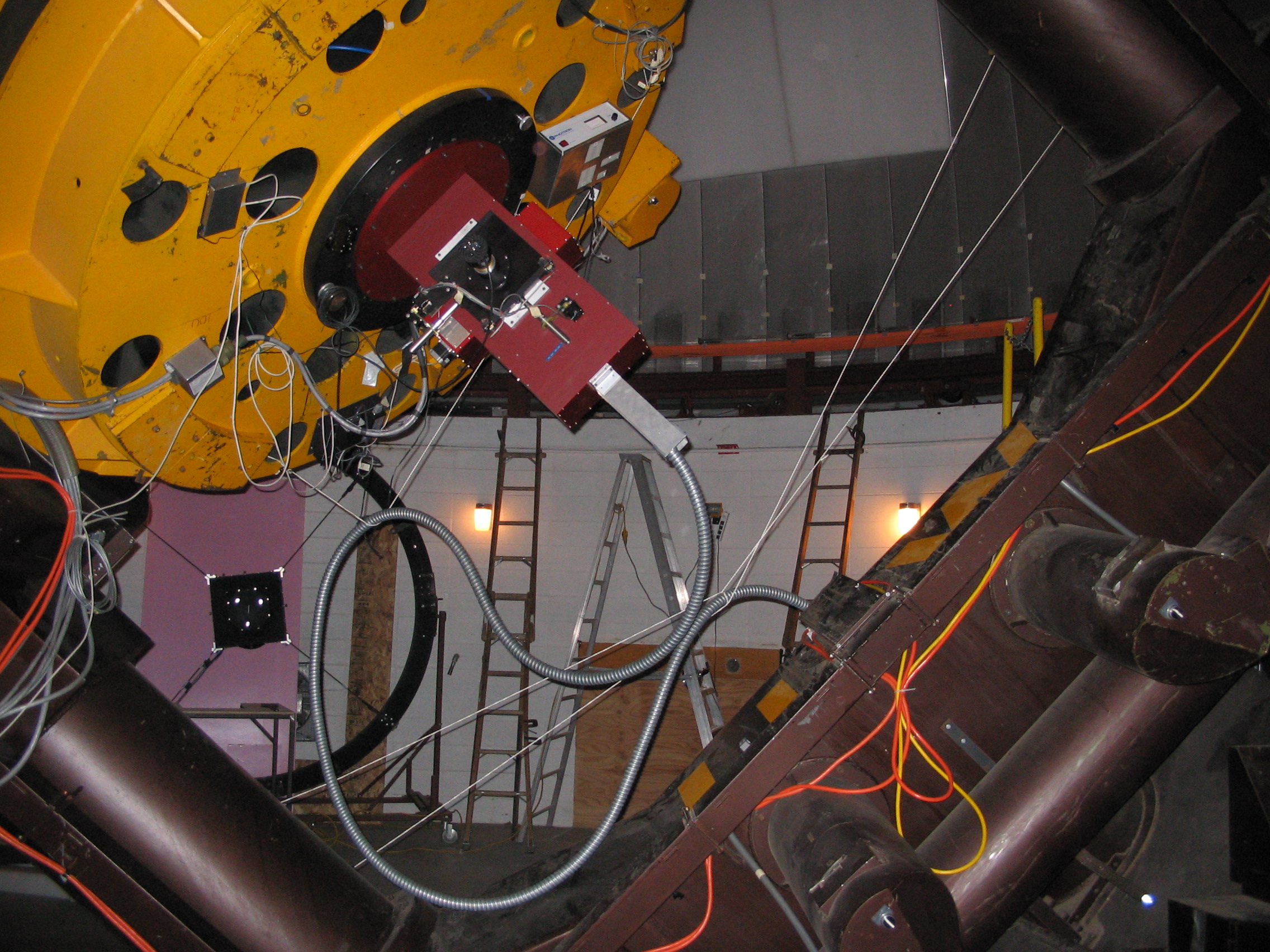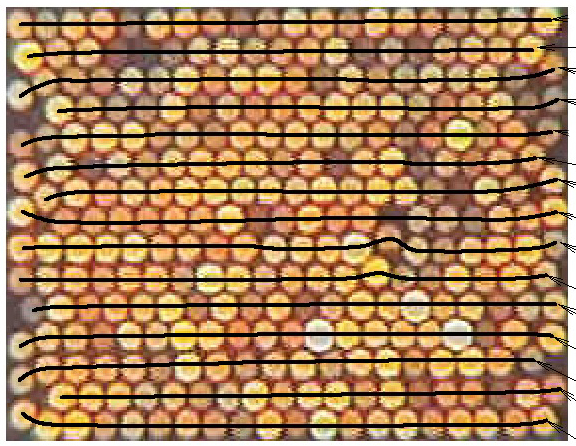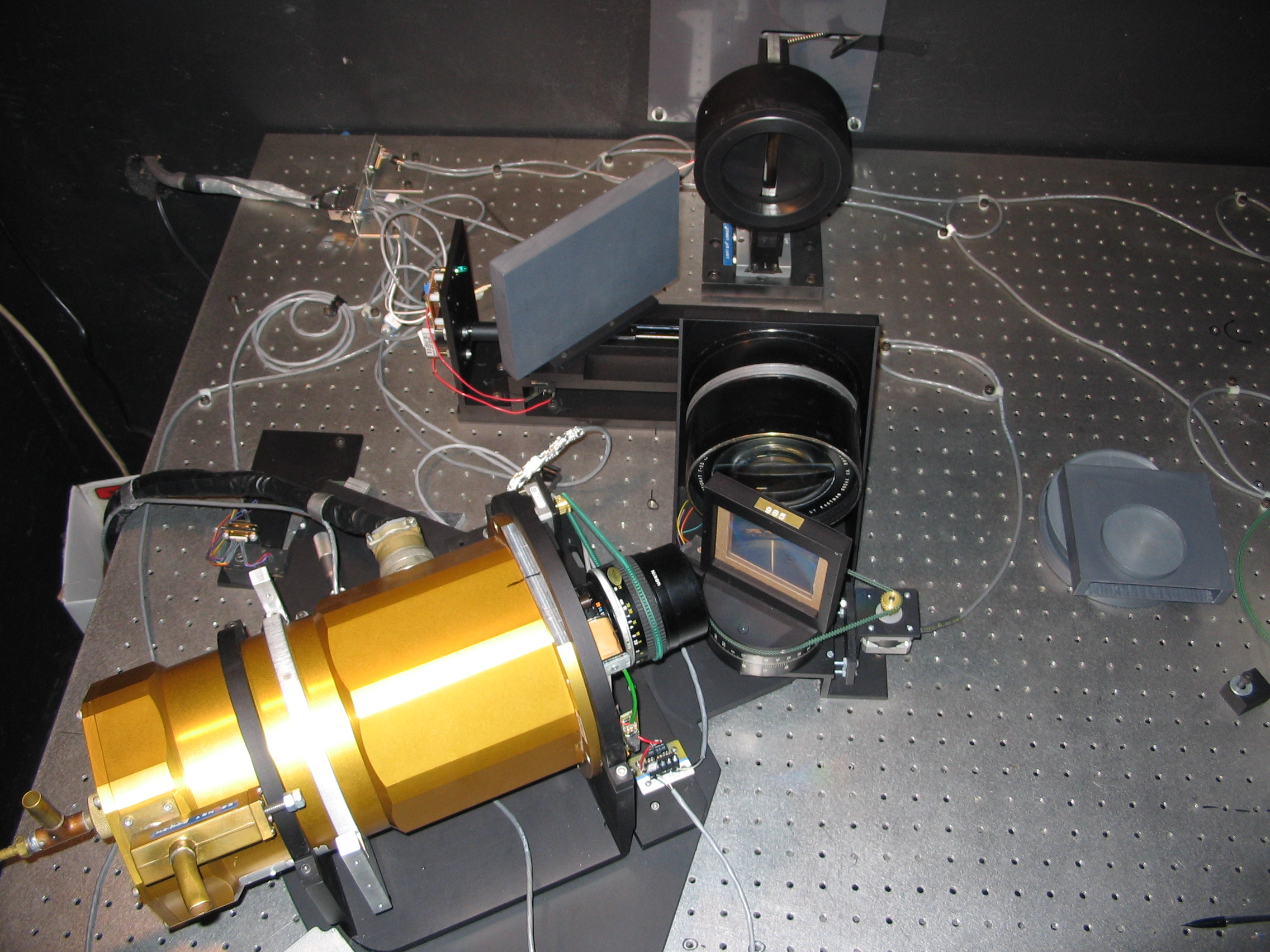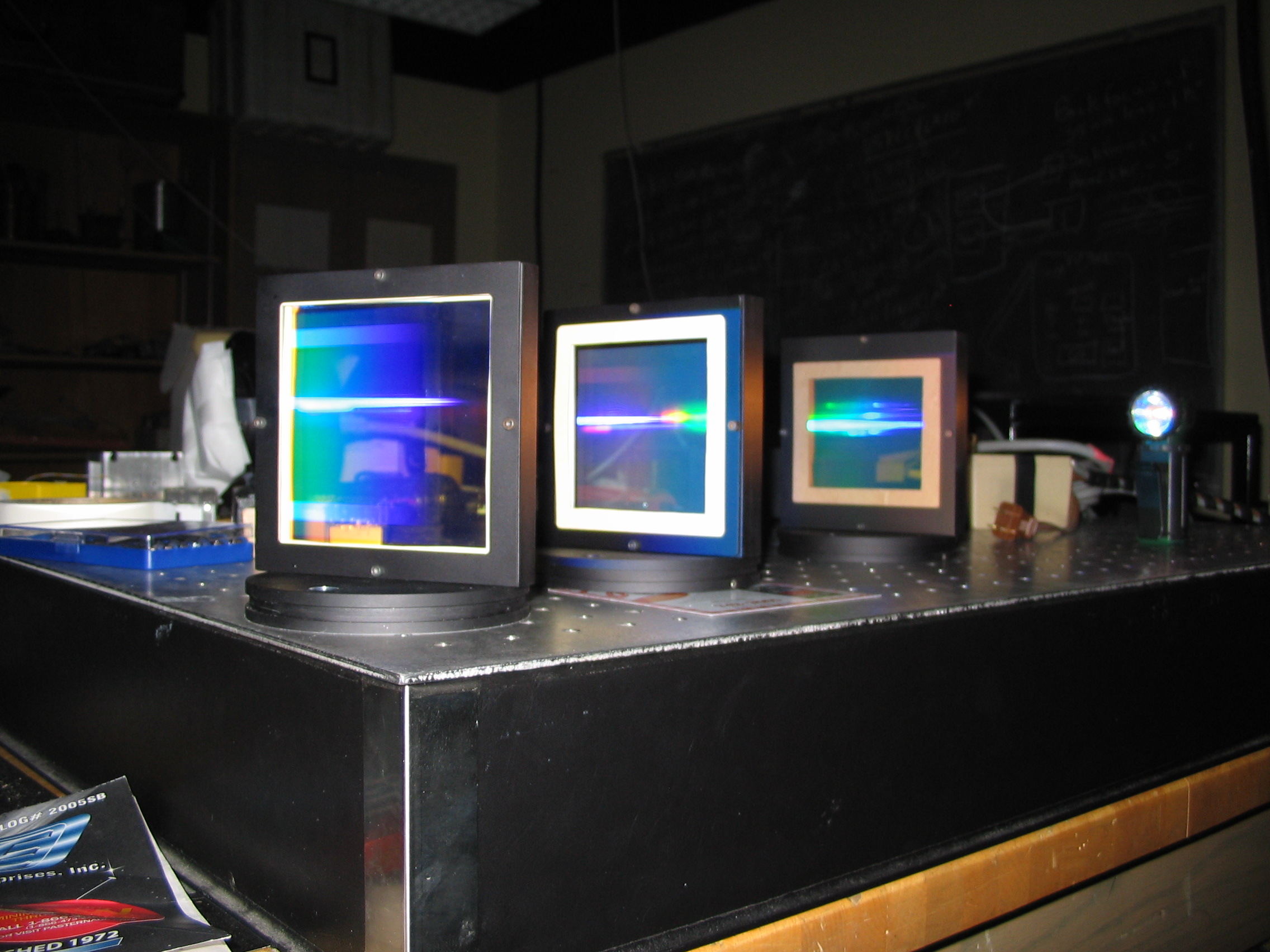WIRO-Spec: An
Integral-Field, Volume-Phase, Holographic Spectrograph(manual
(pdf) (web))
WIRO
Spec is the second of a new generation of facility instruments
developed for the Wyoming Infrared Observatory (WIRO). The
spectrograph was designed by Michael Pierce, Harold Nations and
Philip Haynes. Our primary goal was to provide a high-efficiency
medium-resolution spectrograph for the WIRO 2.3-meter telescope at
low cost. Steve Hodder was the primary machinist for the project and
James Weger developed the electronic design. The instrument is
bench-mounted and located in the spectrograph room. The design
features Volume-Phase-Holographic (VPH) Gratings enabling a total
system efficiency of almost 50%. The optical design features
all-transimission optics with a 345mm f/3.5 collimator and
interchangeable camera lenses mounted on an articulating stage. The
VPH transmission grating is located within these two components and
can be rotated to "scan" in wavelength. With these optics
the 100 um fibers of the 15x20 fiber integral-field unit project to
2.3 pixels with the Marconni/EEV CCD camera (13.5microns/pixel). The
all-transmission design was adopted in order to enable a short
collimated beam. This was necessary to ensure that a long slit (i.e.
lots of fibers) would suffer from little, if any, vignetting losses.
A positive meniscus field lens is located immediately behind the
"slit" to create a geometric pupil at/near the entrance
aperture of the spectrograph camera since this is the element with
the smallest aperture and the most sensitive to vignetting. The
spectrograph is operated in a Littrow configuration since this is the
condition of maximum efficiency for VPH gratings. In this case the
grating equation becomes: nu*lambda=2sin(theta), where nu is the line
frequency (lines/nm) and theta is the incident angle for the grating.
Note that the Littrow condition requires that the camera-collimator
angle be twice the incident angle for the grating (theta). Thus, the
incident angle for the grating can be computed for any desired
wavelength and the camera-collimator angle follows. The telescope is
positioned in order to place a target onto a fiber-optic
integral-field unit. This assembly consists of 293 optical fibers
glued into a hexagonally-packed array of 15x20 fibers each of which
projects to 1 arcsec diameter on the sky. The fiber-optic cable leads
to the bench-mounted spectrograph located on the observatory floor.
At the spectrograph the 293 fibers are formed into a vertical stack
to form a "slit". The spectrograph optics ensure that the
slit is imaged onto the 2048x2048 detector such that the 293 spectra
can be recorded simultaneously. Once the spectra are individually
wavelength calibrated the user can measure velocities, line-ratios,
etc., at any point in the object given the X-Y position of each fiber
in the integral-field array. At present one fiber is broken (#155) is
is hence unusable. Luckily it is located on the edge of the array and
so its impact is negligible.
 Guider
Acquisition Assembly (GAM)
Guider
Acquisition Assembly (GAM)
The
Guider Acquisition Assembly (GAM) is located
at the Cassegrain focus of WIRO and contains the integral-field,
fiber optic array, a small ST-237 CCD for guiding and object
acquisition, and the calibration lamps for the spectrograph. Since
the Cassegrain focus of WIRO is f/27, this assembly also contains
0.33X focal reducing optics in order to produce an f/9 beam such that
the image scale is better matched to the size of the optical fibers.
The figure below shows the GAM mounted on the WIRO telescope. Note
the flexible steel conduit containing the fiber-optic cable extending
from the bottom of the GAM. The bungees provides extra slack in the
cable in order to allow the telescope to be positioned to any point
on the sky without undo stress on the fibers.
 Integral
Field Unit (IFU)
Integral
Field Unit (IFU)
The integral field unit (IFU) of
WIRO-Spec is comprised of a rectangular array of hexagonally-packed
optical fibers. Each 100mm fiber subtends 1.0 arcsec when mounted
behind the 0.33x focal reducer at the Cassegrain focus of WIRO. This
size was chosen as a compromise driven primarily by the 13.5mm pixels
of WIRO-Prime and the desire to minimize vignetting losses due to the
focal ratio degradation from the fibers. The 293 fibers are arranged
into a "15 X 20" array with alternating rows of 20 and 19
fibers. In order to keep the costs of the IFU low, no attempt was
made to map adjacent fibers in the IFU onto adjacent positions along
the slit. The IFU was manufactured by InnovaQuartz
in Phoenix, AZ by gluing each row of
fibers into the IFU assembly. The hexagonally packing of the 120mm
fibers(including the cladding and buffer), results in a 70% packing
fraction for the IFU. At the slit end the fibers were glued into a
slit of 75mm length on 250mm centers. This spacing was chosen
as a compromise between the need for clean separation of the
individual fiber traces on the CCD and the desire to have as many
fibers in the IFU as possible. The figure below shows the back-lit
array and a table of x-y positions vs. slit position(necessary for
the analysis) can be found here.
At the present time one fiber located
on the edge of the IFU is broken (#155).

Mechanical Design
The 293 fibers result in a long slit and hence a large off-axis
angle as seen by the collimator and camera. The need to minimize
vignetting vs. slit position and as a function of wavelength requires
a small collimated beam length. Our design features an articulated
camera consisting of a large, 48º sector, 17-inches in radius.
This allows the spectrograph to be configured over a broad range of
wavelengths. An "imaging mode" can be configured by placing
the grating and camera-collimator angles at 0-deg. This configuration
is provided primarily for engineering tests but it may prove useful
for confirming target acquisition as well. WIRO-Spec is designed to
be fully stepper-motor controlled. This requires 2 stepper motors to
control the camera and collimator focus and 2 more to control the
grating rotation stage and the camera-collimator angle. An additional
stepper motor is used to control the position angle of the IFU making
a total of 5 motors on the spectrograph. The instrument is mounted on
an optics bench in the spectrograph room. The figures below show the
spectrograph in the spectrograph room.

Available
Gratings
Two VPH gratings were kindly provided by
Richard Rallison of Ralcon
Inc. The characteristics
of the two gratings are given in the table below.
|
Grating
|
nu
|
Wavelength
|
Optimal
Angle
|
Efficiency
|
|
2400l/mm
|
2400
l/mm
|
4500
A
|
32º
|
85%
|
|
Ralcon-1
|
1435
l/mm
|
6500
A
|
28º
|
85%
|
|
Ralcon-2
|
985
l/mm
|
8500
A
|
25º
|
85%
|
Instrument Control
Interface
The graphical user interface (GUI) was
designed and programed under Visual Basic 6 by M. Pierce and P.
Haynes. The interface communicates over ethernet to a Compu-motor 6K8
stepper motor controller, allowing the user to select the desired
wavelength and focus the camera and collimator. The figure below
shows the WIRO-Spec GUI. The GUI controls both the spectrograph
configuration and the Guiding and Acquision Module (GAM).
The right side of the GUI is associated with the GAM and the left
side is associated with the spectrograph. The uppermost text box of
the spectrograph control shows the IP address of the 6K8 controller
and the two buttons immediately underneath allow the user to
connect/disconnect to/from the 6K8. The spectrograph GUI allows the
user to select the currently mounted grating from a pull-down menu.
The desired wavelength can then be entered into the text box. The
corresponding grating and camera-collimator angles are computed using
the grating equation. The spectrograph components are then configured
by pressing the go button. The software will then ask the user
to verify that the spectrograph clamps are released before the
components are positioned. The starting and desired wavelengths as
well as the grating and camera angles are displayed in the text boxes
and the components begin to move. The button at lower right will turn
green once the spectrograph components are correctly positioned.
Finally, the software computes the position angle of best focus for
the CCD dewar relative to the camera in order to allow for the small
focus variations with wavelength present in typical camera optics. At
the present time the user must set the micrometer to the computed
position manually in order to achieve the optimum focus. Once the
components are positioned, the camera focus can be adjusted via the
jog buttons. Note that the spectrograph camera focus is very
sensitive to temperature variations and it should be checked at the
beginning of each night using the calibration lamps. It is expected
that the collimator focus will rarely have to be changed.
FITS
Header Editing
At the present time the CCD camera
does not automatically communicate with the telescope control system
(TCS). However, Bob Berrington has written a program to
communicate the telescope information to the Voodoo header.
Otherwise, the Voodoo interface allows the user to edit some the FITS
header parameters. Since Voodoo does not communicate with the
instruments in use and not all of the appropriate KEYWORDS are
automatically written into the header the user is advised to keep
paper logs and/or fill out the header KEYWORDS themselves using the
Voodoo editing tool. Log sheets are available here.
Measured
Performance
Measurements of the individual components
of the spectrograph imply that the overall system throughput should
be about 40%. However, on-sky measurements of spectrophotometric
standards indicate that the efficiency is actually only 15%. The
discrepancy has been traced to a larger focal-ratio degradation than
expected. That is, the output beam from the fibers forming the slit
is faster than expected and light is lost at the collimator. We are
currently investigating the possibility of using an array of
micro-lenses to improve the situation. Stay tuned for updates. Some
spectral images and extracted spectra can be found below.
Last
Modified 05/04/06
Michael
Pierce (mpierce@uwyo.edu), Andy Monson (amonson@uwyo.edu)


